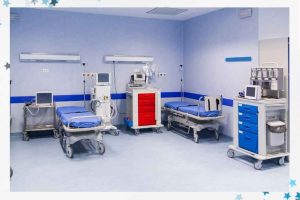Hospital beds vary in size to fit patient needs and comfort. Standard beds, generally 35-36 inches wide and 80 inches long, suit average-sized individuals. More expansive and sturdier Bariatric beds cater to overweight patients. However, it’s worth noting that in certain regions or under specific programs, free hospital beds are available for those in need, ensuring that financial constraints don’t hinder patient care. Specialized beds address unique conditions, such as pediatric or maternity needs. Recognizing these variations ensures optimal care and comfort during hospital stays.
Standard Hospital Bed Sizes
If you’re curious about hospital bed sizes, here are the key points to know:

Twin-size beds are the smallest option, measuring approximately 38 inches wide and 75 inches long.
Full-size beds provide more room, with dimensions of around 54 inches wide and 75 inches long.
For those considering purchasing one for personal or medical use, you want to buy hospital beds from a reputable supplier. Not only will they have a variety of sizes but also models equipped with features tailored to patient needs.
Queen-size beds offer more space still, measuring about 60 inches wide and 80 inches long.
Finally, king-size beds provide the most space, with dimensions of approximately 76 inches wide and 80 inches long.
Twin-Size Bed
Although twin-size hospital beds vary in dimensions, they generally provide enough space for a single patient. These beds are designed to be compact and efficient, making them ideal for hospitals and healthcare facilities with limited space.
With an average width of around 38 inches and a length of 75 inches, twin-size hospital beds offer enough room for patients to rest comfortably while allowing healthcare professionals easy access.
The compact size of these beds also makes them suitable for home use, especially for individuals who require medical care but have limited space.
Twin-size hospital beds are a practical and versatile option for providing comfort and support to patients in various healthcare settings.
Full-Size Bed
You’ll appreciate the spaciousness and versatility of a full-size bed for your healthcare needs.
With a width of 54 inches and a length of 75 inches, a full-size bed provides ample room for patients to move around comfortably.
Whether recovering from surgery or receiving long-term care, this larger bed allows for better mobility and positioning.
It can accommodate individuals of various sizes and provides enough space for caregivers to assist with medical procedures or daily tasks.
A full-size bed offers enough room for family members or loved ones to sit or lie beside the patient, providing comfort and support during their stay at the hospital.
Queen-Size Bed
When creating a luxurious and spacious sleeping experience, nothing compares to the comfort and versatility of a queen-size bed.
With dimensions measuring approximately 60 inches in width and 80 inches in length, a queen-size bed offers ample space for individuals or couples to stretch out and relax.
Whether you prefer to sleep alone or share your bed with a partner, a queen-size bed provides enough room to accommodate different sleeping positions and movements throughout the night.
Queen-size beds are popular for master bedrooms, guest rooms, and even hotel suites because they provide a comfortable and indulgent sleep environment.
So, if you’re looking for a bed that offers both style and functionality, a queen-size bed is definitely worth considering.
King-Size Bed
Indulge in the ultimate luxury and experience the blissful comfort of a king-size bed. These beds are the epitome of spaciousness, providing ample room to stretch out and relax.
With dimensions of approximately 76 inches wide and 80 inches long, a king-size bed offers plenty of space for couples to sleep comfortably without feeling cramped.
Whether you prefer to sprawl out or cuddle up with your loved one, a king-size bed ensures you have enough space.
So treat yourself to the grandeur of a king-size bed, and enjoy a truly restful and rejuvenating sleep experience.
Bariatric Hospital Beds
If you or your loved one requires specialized care and support due to obesity, bariatric hospital beds are designed to meet your unique needs.

These beds offer a broader and sturdier frame to accommodate higher weight capacities, ensuring safety and comfort during hospital stays. You wonder, how much do hospital beds weigh? While the specific weight can vary depending on the model and features, it’s evident that these bariatric beds are built with added strength and durability.
In addition to their robust construction, bariatric beds usually Usually come equipped with features like adjustable height, reinforced side rails, and specialized mattresses to provide optimal support for individuals with larger body sizes.
Overview of Bariatric Beds
Bariatric beds, explicitly designed for the comfort and safety of larger patients, are larger and broader than standard hospital beds. These beds are built to accommodate individuals who weigh over 350 pounds, with models supporting weights of up to 1,000 pounds.
The width of a bariatric bed commonly ranges from 42 to 48 inches, compared to the standard 36 inches of a regular hospital bed. The extra width provides ample space for patients to comfortably move around and reposition themselves.
Bariatric beds frequently feature reinforced frames and heavy-duty mechanisms to ensure stability and durability. These beds are also equipped with specialized mattresses that distribute weight evenly and reduce the risk of pressure ulcers.
Overall, bariatric beds are essential in providing support and comfort for larger patients in healthcare settings.
Features of Bariatric Beds
To fully appreciate the benefits of these specialized beds, you’ll find that they boast an array of features tailored to the unique needs of larger patients. Bariatric beds are designed to provide increased weight capacity, naturally ranging from 500 to 1,000 pounds, ensuring the safety and comfort of the patients.
These beds also feature more comprehensive mattress platforms, ranging from 42 to 54 inches, providing ample space for more prominent individuals. They have reinforced frames and heavy-duty motors to support the additional weight. Bariatric beds constantly come with adjustable height settings, allowing healthcare professionals to quickly access and care for the patients.
Models offer advanced features like built-in scales, pressure redistribution mattresses, and integrated patient monitoring systems. Overall, the features of bariatric beds aim to enhance the well-being and quality of care for larger patients.
Specialized Hospital Beds
In this subtopic, we will discuss specialized hospital beds that cater to specific needs.

Pediatric beds are designed to provide a safe and comfortable environment for children receiving medical care.
Birthing beds are tailored to support women during the labor and delivery process.
Trauma beds are specially equipped for patients with severe injuries or critical conditions.
These beds are essential in ensuring optimal patient care and support in these specific situations.
Pediatric Beds
Did you know pediatric beds are designed to be smaller and more comfortable for children?
These beds are normally narrower and shorter than adult beds, allowing young patients to feel more secure and less overwhelmed in a hospital setting.
Pediatric beds repeatedly come with additional features such as side rails, adjustable height options, and colorful designs to create a more child-friendly environment.
The mattresses are also designed to be softer and more supportive, ensuring children’s comfortable and restful sleep.
These specialized beds provide pediatric patients the best care and comfort, allowing them to recover and heal in a space tailored to their unique needs.
Birthing Beds
Now let’s talk about birthing beds, an essential part of maternity wards. These beds are designed to provide comfort and support to expectant mothers during childbirth.
Birthing beds can vary depending on the hospital, but they’re generally more extensive than standard hospital beds to accommodate the mother’s movements and the medical equipment needed during delivery. These beds constantly have adjustable features such as height and backrest positioning to ensure optimal comfort for the mother and facilitate the work of medical professionals attending to the birth.
Birthing beds are crucial in creating a safe and comfortable environment for the birthing process, allowing mothers to focus on the miracle of bringing new life into the world.
Trauma Beds
Imagine lying on a specialized bed that provides comfort and support during trauma, allowing medical professionals to attend to your needs efficiently.
Trauma beds, also known as critical care beds or intensive care beds, are larger and more advanced than standard hospital beds.
These beds are naturally broader and extended, measuring around 36 to 48 inches wide and 80 to 84 inches long, providing ample space for patients requiring additional medical equipment or assistance.
They have various features,For instance such as adjustable height, side rails, and mattress positioning to ensure maximum patient comfort and safety.
Trauma beds are designed to accommodate patients with complex medical conditions, allowing medical professionals to access and treat their injuries or perform necessary procedures efficiently.
With these specialized beds, hospitals can provide the best care possible for patients experiencing traumatic events.
Conclusion
In conclusion, hospital beds vary in size, from standard beds measuring 35-36 inches wide and 80 inches long to more expansive bariatric beds for heavier individuals. Specialized beds, like pediatric or maternity options, cater to specific needs, while ICU beds offer advanced features for critical care. The bed size chosen reflects the patient’s needs and comfort.
